Welcome to Samland 2.0. This is one man’s attempt to understand and document public places that respect people. Sometimes those spaces are inside of theme parks and at other times they are out there in the big world. Welcome to my journey.
THE CITY OBSERVED: DISNEYLAND
When one reviews the critical literature regarding the topic of Disneyland, they would find opinion tends to fall into two camps. On one hand are those who bash the park and suggest that its existence is partially responsible for the downfall of our culture. On the other hand, are those who can’t find anything wrong and believe in the magic even when they can see the wizard standing right over there. Of course, there are some good works somewhere in the middle but those are rare. One such book is The City Observed Los Angeles by Charles Moore, published in 1984.
Moore was a famed and talented architect and one of the most articulate observers of the built environment. By including Disneyland as an equal in his critical look at architecture throughout the Southern California region, he makes a major statement about the importance of the park on the way we perceive architecture. The book is a professional reflection on Disneyland just before the new regime of Michael Eisner and Frank Wells. Let’s jump into our time machine and see what Charles Moore had to say.
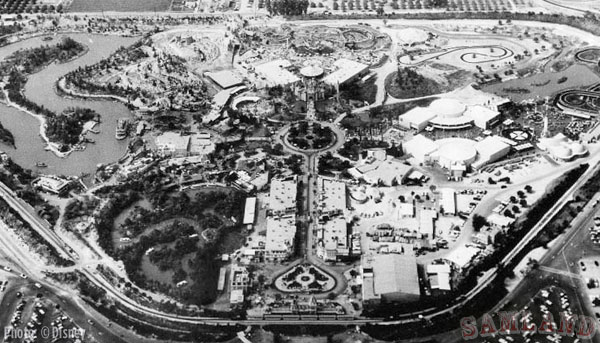
The Disneyland chapter follows a description of downtown Los Angeles. What Moore suggests is the notion that the real heart of Los Angeles is actually at Disneyland. He called Disneyland “an altogether synthetic and recent Place.” While many of his peers have written off Disneyland by this time, Moore says, “What may come as a surprise is how richly Disneyland offers us insight into many layers of reality.” He proclaimed, “This incredibly energetic collection of environmental experiences offers enough lessons for a whole architectural education and all the things that matter – community in reality, private memory and in habitation, as well as some technical lessons in propinquity and choreography.” Propinquity is how to describe the close juxtaposition of very disparate places. Imagineering still does this better then anyone.
For those looking for a philosophical discussion to fill in the time while in line, you may want to start with a question Moore asks himself. Which is more real: Disneyland or Santa Barbara which went “Spanish” after an earthquake in 1925? Moore includes Disneyland in the discussion of Southern California architecture because it satisfies “the human act of being somewhere where we are protected, even engaged, in a space ennobled by our own presence.”
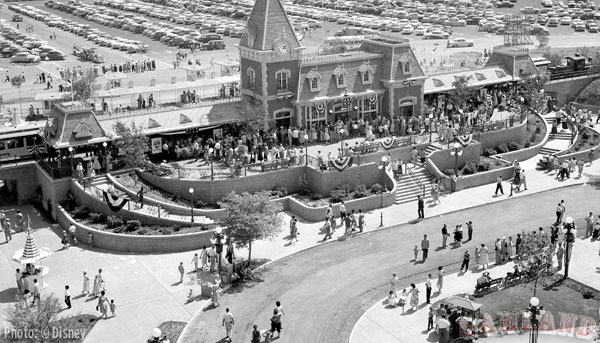
The tour begins, naturally, on Main Street USA. Moore describes the street as “a family album of smiling snapshots.” He is most impressed by the trees, which “provide a reality on an immediate level that remains unsheltered by the appearance of the plastic Matterhorn above palm trees, olive trees and umbrellas.”
Here is how Moore interprets a walk through Adventureland. He notices how the architecture changes from “mostly Mexican – except that the places where awnings might be expected are thatch” to “more African” and “then slopes off into a kind of Caribbean mode with awnings sheltering a big game shoot.” That is not all. Next is “a building that would be at home in Timbuktu” filled with Guatemalan weavers. Nearby was a “multiply coned and thatched gazebo” and then “to the final building of the group – pure Beverly Hills French.” The result is “the whole dazzling stretch from Mexico to Beverly Hills is made to work by an intensely sophisticated eye toward ornament.”
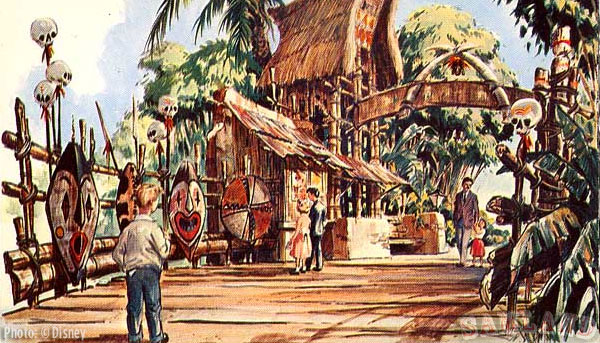
Another delight within the Disneyland berm are the “more casual, spur-of-the-moment opportunities like a visit to the Swiss Family Robinson Tree House.” Beyond his fascination with the clever reuse of salvaged items from the shipwreck, he notices how high people will climb up the stairs “without much noticeable physical exertion.” Of course, Tarzan has taken up residence since Moore visited. For me, the King of Jungle is not quite the same as the Robinson family. While walking through their house it was easy to imagine living there. Otherwise, why would Tarzan have a treehouse. Wouldn’t it be Jane’s Treehouse. Okay, over thinking again.
Which brings us to Pirates of the Caribbean. Moore suggests the ride “falls somewhere between the creation of a setting and the telling of a story.” He was not fond of the cavern scenes calling them “the attic of a theatrical costume emporium.” Moore notices that the “wanton cruelty and greed” is “rendered harmless and therefore not especially interesting by that curious Disney touch that so hams up and thereby emasculates evil.” He is not fond of Pirates. “It’s astonishing how this pin-brained apotheosis of sloth and stupidity can be so fascinating.”
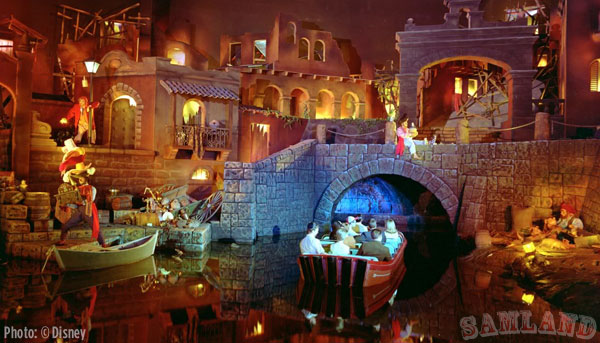
He is also not a fan of the Haunted Mansion. Although the ride “is surely one of the most skillful, sophisticated and engrossing spatial sequences on the planet” it is ultimately “a badly flawed ride, if only for the smug and supercilious treatment it bestows upon ghosts, just because they are dead.”
Over in Frontierland, things were different. This was a time when there was a “posh” Pendleton Woolen Mill shop “for fancy dressers from foreign lands.” Even the Shooting Gallery was using real bullets and the targets had to be repainted every night. While riding the Mark Twain, Moore suggests “the edge of the river is particularly beautiful near the spot where Indians appear to have shot a settler.” Moore admired Tom Sawyer Island. Walt Disney personally designed the shape of the island. “Adults almost always find everything too small and boring, preferring instead the more complex, carefully orchestrated amusements of the mainland.” That is what we get for growing up (some of us).
Moore was also a fan of Nature’s Wonderland. He said, “It was one of Disney’s most successful mixes of real and fantastic – the naturalness of the fairy tale and the fantasy of nature.” By the time of this visit, the gentle train ride had been replaced with Big Thunder Mountain Railroad. Although the new ride meant “having your neck snapped…that there is little left for environmental observation.” He did enjoy the queue for the coaster and it’s ability to set the mood.
He found much to love in Fantasyland. Mr. Toad Wild Ride, Peter Pan’s Flight, Storybookland Canal Boats, and Casey Jr. Circus Train are all favorites. However, he warns to stay away from it’s a small world because “it so exaggerates the goody-goody aspects of Disneyism as to make them intolerable” and the theme song. On the other hand, he does recommend the Skyway to Tomorrowland because the “passage through the Matterhorn is one of the most exciting, revealing and moving moments in all of Disneyland, or anywhere.” Sadly, that experience is long gone.
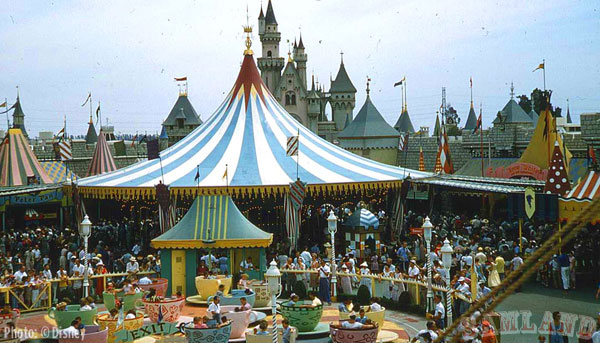
By the time Moore visited Tomorrowland, he said, “All that’s left in Tomorrowland is the past’s look into the future, which today is a slightly chilling period piece.” It was “a bland arrangement that looks more like downtown Santa Monica than twenty-fifth-century Omaha of Buck Rogers or the splendid sleek sets for the movie of H.G. Well’s Things to Come.” His description of the WEDway PeopleMover was spot on. He said, “An early ecological solution meant to please everyone, it runs on pollution free all electric energy to salve the environmentalist, offers individual modules for those accustomed to their own car, and sports just enough new technology to impress the professionals.” He especially enjoyed taking the Monorail to “Adultland” at the Disneyland Hotel.
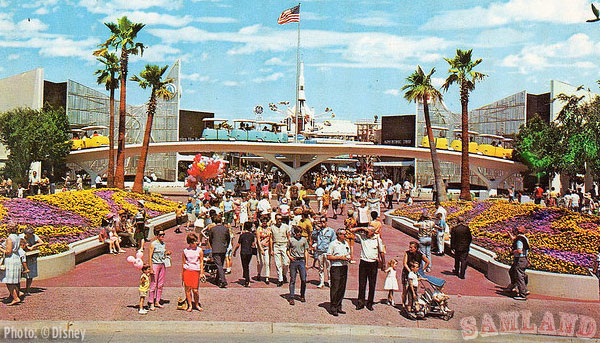
Even in 1984 it was becoming obvious that Disneyland was using Tomorrowland to be the catchall for everything that just didn’t fit elsewhere, America Sings for example. “The show is well paced and visually dazzling and it contains some perfectly decent and praiseworthy American folk songs several cuts above the musical fair elsewhere in Disneyland,” Moore said. But it’s placement in tomorrowland is only due to the carousel theater and the use of robotic characters.
Moore visits the Submarine Voyage, Mission to Mars, and Space Mountain. He ponders the need for Autopia. He said, “It may seem outrageous to those of us who just bought miles of freeway traffic on the way to the Magic Kingdom to discover that this miniature freeway is one of the most popular rides in the park.” However, Autopia does serve a purpose. He suggests that the ride is “an opportunity to organize young people into a less threatening version of a role they will assume as adults.” The result? “A stress-filled necessity becomes miniaturized, understandable but really – a training freeway.”
Time to return to the present. Do you agree with Charles Moore?
Every story has a beginning, and the Walt Disney story begins in Chicago in a little two story house designed by Walt’s mom and built by his dad in 1893. Please join me in supporting the effort to save this historic house before it is lost forever! There are three ways you can get involved. First, you can donate to their crowd funding project at http://StartSomeGood.com/WDB. And if you live in the LA or Orlando areas, there are two upcoming events in your neighborhood (see below).
Broadway Sings Disney in benefit of the Walt Disney Birthplace – Nov 17th, Studio City, CA
Broadway’s Michael-Leon Wooley, also known as the voice of Louis the Alligator from Disney’s The Princess and the Frog, is hosting a night of Broadway performers singing your favorite Disney songs in benefit of the Walt Disney Birthplace restoration! This very special show is a great opportunity to do some good and have an amazing time. It’s the ultimate win/win event!!!
An Evening with Bob Gurr
Who says that all of the good events are held in California? If you are close to Walt Disney World you can spend a magical evening with Disney Legend Bob Gurr in beautiful Celebration, Fl. This cocktail party type event will include special guests, Magic, Memories, and a rare opportunity to meet a true Disney Legend and learn more about the man who started it all . . . Walt Disney!
Bob was hired by Walt Disney himself to work on Disneyland. He has spent countless hours with the legendary Uncle Walt and eagerly shares amazing stories about those early days at the magic factory. What was the code word around the studio for when Walt was in a bad mood? What was the tell tale sign that Walt was getting agitated? Just ask Bob! He’ll be there, Gurrtini in hand, to share his recollections from the day he was hired on at Disney Imagineering. This is also the perfect way to close out your visit to the IAAPA convention if you plan on being in town that weekend.
There are an extremely limited number of tickets available for this private affair, and some exclusive opportunities will be available for event attendees. Don’t miss out on this one-of-a-kind night, and the opportunity to meet a true Magic Maker!
Sam’s collection of theme park books continues to grow. His newest book, diving into the history of Universal Studios, will release in December.



You must be logged in to post a comment.